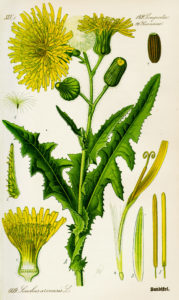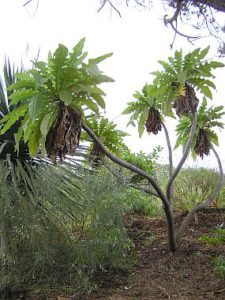Sonchus breeding
Track 1: Domestication of local Sonchus species
Sonchus is a genus of plants closely related to Taraxacum, home genus of the common dandelion. They are commonly referred to as “Sow thistles”, and like dandelions are a very nutritious edible green. When I see particularly vigorous Sonchus growing as weeds, I dig them up and bring them home. The first step of breeding is selection!
There are a few species that grow locally as weeds. I’m selecting for vigorous growth, large leaves, ability to grow through the winter, and for the perennial species, I’ll select for lifespan if that appears to be limited.
The name “Sow thistle” comes in part from the appearance… which includes little spines down the centers of the leaves. On young leaves, which are most desirable for eating, the spines are soft and not a problem. On older leaves, they can harden up and start getting annoying. I’m planning to not exert any selective pressure here. I figure the spines are there as a pest deterrent, and I’m very happy for the plants in my garden to deter pests on their own. It saves me work! I can wear gloves if I need to.
Same thing with the bitter taste – there is a longstanding tradition that some bitterness is critical for digestion, and there is an increasing body of science that backs that up. Instead of trying to select away the incredible health value of this, I’d rather work on adapting my preferences and recipes to make the bitterness enjoyable. Also, from the plant’s point of view, the bitterness helps keep it less eaten by other pests. Again, I like my plants defending themselves.
Track 2: Cold-hardy Sonchus from the Canary islands
I’m also pursuing another track of this project: working towards increasingly cold-hardy Sonchus species native to the Canary Islands. These shrubs are commonly called “tree dandelions”, because they look like a dandelion that is a tree. There are reports of some of them living as dieback perennials through frosts. And as long as I can get survivors in our climate, I’ll be able to breed forwards towards increased hardiness – with the dream of having fully frost tolerant tree dandelions. My neighbors will love me for it, I’m sure…

These don’t have spines, so that isn’t a question. They do reportedly have bitterness, and I’ll take the same stance here as with the domestic weedy Sonchus species.
Mostly the goal is to acclimate one or more of these fantastic species to my area. The chief obstacle will be cold tolerance, and I’ll have to see what other issues crop up. The nurseries and seed companies that sell these species always talk about temperatures like +10 C as the minimum for the plants to survive. I’ve found a few mentions online of people in the UK overwintering Sonchus fruticosus as low as -9 C. It sounds like that only works with young growth that dies back – if they are too woody, then they are completely killed.
Early in the project, I’ll provide some protection for at least a portion of my breeding stock, but once I’ve grown out some seed, I’ll try to plant a large number of them somewhere with no protection in hopes of finding individuals that tolerate the cold better.
A possible complication will be if these species produce seeds via apomixis, where all the seeds produced are simply a clone of the parent. Many varieties of common dandelion only produce seeds this way – and if the tree dandelions do the same, then it’ll not give me much diversity to work with. I’m hoping that apomixis isn’t an issue, and that if these do utilize apomixis, that they also can produce seed sexually. I won’t be able to tell for sure. I’ll just keep an eye out for if the seedlings have any diversity or not.
I currently have S. palmensis and S. congestus in little pots, and have seeds for S. fruticosus coming in the mail. Next year, if all goes well, I’ll have plenty of seeds from all of those to share.
Third track: Mix it up!
Before I stumbled on the freeze-tolerance stories, my plan was to cross my domestic Sonchus with the tree-ish ones. Now that it looks like there may already be some frost tolerance in at least one of the Canary island species, this is on the back burner. I might try making a cross if I have time, because it would be interesting, but it no longer seems necessary to the purposes of getting local dandelion trees.
Interested?
If you’re interested in following this project or getting seeds when I have them, you can email me at [email protected].